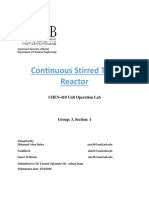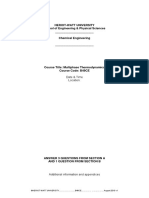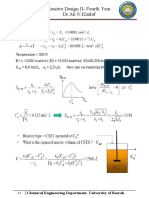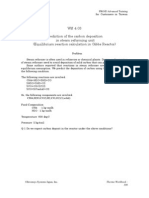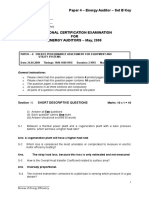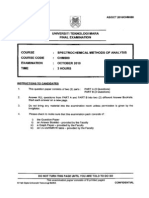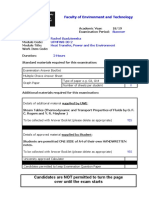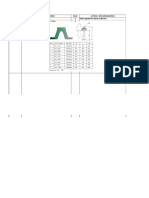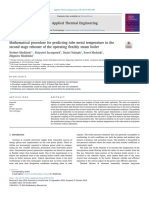Che571 Che584 Che594
Che571 Che584 Che594
Uploaded by
Alif Aikal Che HatCopyright:
Available Formats
Che571 Che584 Che594
Che571 Che584 Che594
Uploaded by
Alif Aikal Che HatOriginal Description:
Original Title
Copyright
Available Formats
Share this document
Did you find this document useful?
Is this content inappropriate?
Copyright:
Available Formats
Che571 Che584 Che594
Che571 Che584 Che594
Uploaded by
Alif Aikal Che HatCopyright:
Available Formats
CONFIDENTIAL
EH/OCT 2009/CHE571/584/594
UNIVERSITI TEKNOLOGI MARA FINAL EXAMINATION
COURSE COURSE CODE EXAMINATION TIME
CHEMICAL REACTION ENGINEERING CHE571/584/594 OCTOBER 2009 3 HOURS
INSTRUCTIONS TO CANDIDATES 1. 2. 3. This question paper consists of five (5) questions. Answer ALL questions in the Answer Booklet. Start each answer on a new page. Do not bring any material into the examination room unless permission is given by the invigilator. Please check to make sure that this examination pack consists of: i) ii) iii) iv) the Question Paper an Answer Booklet - provided by the Faculty a one - page Appendix a graph paper - provided by Faculty
4.
DO NOT TURN THIS PAGE UNTIL YOU ARE TOLD TO DO SO
This examination paper consists of 6 printed pages
Hak Cipta Universiti Teknologi MARA CONFIDENTIAL
CONFIDENTIAL QUESTION 1
EH/OCT 2009/CHE571/584/594
The elementary liquid-phase irreversible reaction of C2H4 + H20 - C2H5OH is to be carried out in a flow reactor. Two reactors available are an 800 dm3 PFR that can only be operated at 300 K and a 200 dm3 CSTR that can be operated at 350 K. The two feeds stream to the reactor mix to form a single feed stream that is equal molar in C 2 H 4 and H20, with a total volumetric flowrate of 10 dm3/min. Determine the best reactor for this reaction and justify your answer. Additional information: At 300 K, k = 0.07 dm3/mol.min E = 85000 J/mol.K CAO = C BO = 2 mol/dm3 VAO - VBO = 0.5v0 = 5 dm3/min (20 marks)
QUESTION 2 a) In each of the following reactions determine the specific reaction rate constant for each of the other species in the reaction. Assume that k in each case has a value of 25 with the approximate combination of units of mol, dm3 and s. i. For the reaction of ~N2+-H2 The rate law is - rNi = ii. kNCNCHi -+NH2
For the solid catalyzed reaction, 4NH3 + 50 2 -> ANO + 6H20 The rate law is -r'NHi = kNHC2NHC0i (7 marks)
b) In the homogeneous gas-phase reaction, CH4 + -02 -> HCOOH + H20
State the relationship between /"c/-/4 and r0^ . (2 marks)
Hak Cipta Universiti Teknologi MARA
CONFIDENTIAL
CONFIDENTIAL
EH/OCT 2009/CHE571/584/594
c) State the rate expression for each species in the following reaction i. ii. For the reaction of
"1
For the reaction of
->s-
. D
"2
>C
AA-
+D ^U
(6 marks)
QUESTION 3 Typical curve of a reaction carried out isothermally is shown in Figure 1, while the curve shown in Figure 2 is typical of an exothermic reaction carried out adiabatically. a) Assuming that you have a CSTR and a PBR containing equal weights of catalyst, suggest the arrangement of the reactor for an isothermal reaction and adiabatic reaction. (4 marks) b) Calculate the catalyst weight necessary to achieve 80% conversion for single CSTR and PBR. Comment your answer. (8 marks) c) Recommend the best reactor arrangement for different -r A versus X curves. (3 marks)
1000
o E w E
0.2
0.4
0.6
0.I
1.0
Conversion, x Figure 1 Processed data
Hak Cipta Universiti Teknologi MARA
CONFIDENTIAL
CONFIDENTIAL
EH/OCT 2009/CHE571/584/594
60 50 > >
CD O
40
O) XL
30 20
<
10
0.2
0.4 0.6 0.8 Conversion, x
1.0
Figure 2 Exothermic reaction
QUESTION 4 CSTR frequently is less costly and easier to maintain and one or more CSTRs can frequently be preferred over a PFR. However, when selectivity and yield of a given product need to be maximized, the design issues become more complicated. Engineers, Aqso and Madina are assigned to design the reactor for production of ethylene from ethane with acetylene as a byproduct. If the reaction can be considered as first order series reaction, for 90% conversion determine the followings: Holding time Reactor volume Concentration of ethylene iv. Selectivity v. Yield Based on the determined criteria above, recommend the best reactor that should be designed for this system and justify your answer. Given, v = 4 liter/min C A 0 = 2 moles/liter k-i =0.5min" 1 k-, =0.1min -1 (20 marks)
Hak Cipta Universiti Teknologi MARA
CONFIDENTIAL
CONFIDENTIAL QUESTION 5
EH/OCT 2009/CHE571/584/594
a) The second order irreversible liquid phase isomerisation reaction of normal butane to isobutene, nCAHw -> iC4Hl0 is carried out adiabatically in a CSTR. Butane and an inert I (which contains the catalyst) are fed to the reactor in equal molar amounts at a temperature of 57C and a total volumetric flow rate of 163 kg.mol/hr. The concentration of butane entering the reactor is 9.5 kg.mol/m3. Determine the reactor volume to achieve 80% conversion. Additional information: AHnn =-6900 J Imol
k = 31.1/hr at S7C E = 65.7kJImol CPA =\4U/mol.K CPB = \4Ulmol.K Cn =\6U/mol.K
x
EB
&,C[T-TQ]
-AH^+AC^T-T,]
(10 marks)
b) The following reversible elementary liquid phase reaction of vinyl allyl ether to n-pentaldehyde-ene-4 occurs in a PFR: CH2 = CHCH2OCH = CH2 ^ = > CH2 = CHCH2CH2CHO The entering flow rate is 10 dm3/s with an entering concentration of 2M of pure vinyl allyl ether and the feed temperature is 310 K. The specific reaction rate and equilibrium constant are shown in Figure 3 and Figure 4 respectively. Determine the reactor volume necessary to achieve 90% of the adiabatic equilibrium conversion in one operated adiabatically. Additional information:
CP =CP = 50 cal fmol.K
'A
r
fl
^H'RXN
= -10000 cal I molA rB Kc
(20 marks)
-rA =k CA
Hak Cipta Universiti Teknologi MARA
CONFIDENTIAL
CONFIDENTIAL
EH/OCT 2009/CHE571/584/594
zu 1o 1C
ID
14 " 19 * " { / > m lU O" D ~
A -
9. 0 300
320
340
360
380 400 420 Temperature (K)
440
460
480
500
Figure 3 Specific rate reaction
uu 90 on OU 7D Rn DU ou 40 OU
"3ft
on
1nIu 0-
300
320
340
360
380
400
420
440
460
480
500
Temperature (K) Figure 4 Equilibrium constant
END OF QUESTION PAPER
Hak Cipta Universiti Teknologi MARA
CONFIDENTIAL
CONFIDENTIAL
APPENDIX 1
EH/OCT 2009/CHE571/584/594
Simpson's one third rule:
J
fV(x)cfx = ^ ( x 0 )
x0 j
4f(x 1 ) + / r (x 2 )]
Simpson's three-eighths rule: j * V (x)dx =h[f
J
(x 0 ) + 3f (x,) + 3f (x 2 ) + f (x 3 )]
X0
Five-point quadrate formula:
J
f4f(x)dx=l[f0+4fl+2f2+4f3+f4]
x0 i
Hak Cipta Universiti Teknologi MARA
CONFIDENTIAL
You might also like
- Tutorial 11Document5 pagesTutorial 11Aakash R RajwaniNo ratings yet
- Sample ExamDocument6 pagesSample ExamTuấn Kiệt NguyễnNo ratings yet
- Continuous Stirred Tank Reactor: CHEN-410 Unit Operation LabDocument34 pagesContinuous Stirred Tank Reactor: CHEN-410 Unit Operation LabMohamad Abou DaherNo ratings yet
- Irrigation Drawing ManualDocument46 pagesIrrigation Drawing Manualkalai vaani100% (2)
- ATR Ata - 29 - Hydraulic - PowerDocument60 pagesATR Ata - 29 - Hydraulic - PowerJesús Montalvo Fernández100% (2)
- CHT305 SyllabusDocument8 pagesCHT305 SyllabusYuxin CasioNo ratings yet
- MTA QuestionDocument3 pagesMTA QuestionArissa HaniNo ratings yet
- CHE471Document7 pagesCHE471MaizatulAkmaNo ratings yet
- CHP303 PDFDocument43 pagesCHP303 PDFPrakhar MisraNo ratings yet
- Che502 Mid Term Assessment May 2021 HimDocument3 pagesChe502 Mid Term Assessment May 2021 HimLehbron JemsNo ratings yet
- Tutorial 4 - Chapter 4Document13 pagesTutorial 4 - Chapter 4Fiz Mobile Gaming & MoreNo ratings yet
- B49CE Exam Answers v1Document40 pagesB49CE Exam Answers v1Konul AlizadehNo ratings yet
- Lab 5 Production of Ethyl ChlorideDocument19 pagesLab 5 Production of Ethyl ChloridelynNo ratings yet
- Ch. 10 PDFDocument20 pagesCh. 10 PDFDr.AhmedNo ratings yet
- Reactor Design II-Fourth Year DR - Ali N.Khalaf: Chemical Engineering Department - University of BasrahDocument11 pagesReactor Design II-Fourth Year DR - Ali N.Khalaf: Chemical Engineering Department - University of BasrahKORAMA KIEN100% (1)
- Mid Semester Examination Faculty of EngineeringDocument3 pagesMid Semester Examination Faculty of EngineeringSunmoon Al-HaddabiNo ratings yet
- Pro2reactor PDFDocument29 pagesPro2reactor PDFJoy DasNo ratings yet
- Paper-4 SetB Key Final 8may2009Document10 pagesPaper-4 SetB Key Final 8may2009chkk.ramakumarNo ratings yet
- CKB 20104 - Reaction EngineeringDocument9 pagesCKB 20104 - Reaction EngineeringNoor FatihahNo ratings yet
- Paper-4 SetB Key Final 8may2009Document10 pagesPaper-4 SetB Key Final 8may2009Erin WardNo ratings yet
- Bkf1243-Analytical Chemistry 21314 PDFDocument9 pagesBkf1243-Analytical Chemistry 21314 PDFrushdiNo ratings yet
- Seminar Assignments - Assignment 5 Questions + Answers Seminar Assignments - Assignment 5 Questions + AnswersDocument5 pagesSeminar Assignments - Assignment 5 Questions + Answers Seminar Assignments - Assignment 5 Questions + AnswersHenry KimNo ratings yet
- P4S1Document4 pagesP4S1NatarajNo ratings yet
- CRE I Assignment 5Document2 pagesCRE I Assignment 5Sumit KatkarNo ratings yet
- 660 PDFDocument2 pages660 PDFAravind KumarNo ratings yet
- Ethylene Dichloride Production by Oxychlorination in A Fluidized Bed Reactor With CFD ModelDocument14 pagesEthylene Dichloride Production by Oxychlorination in A Fluidized Bed Reactor With CFD ModelJam ImtiazNo ratings yet
- Cemi323 Pknov14Document9 pagesCemi323 Pknov1430017149No ratings yet
- CHE471Document5 pagesCHE471ShahrizatSmailKassimNo ratings yet
- Paper4Document4 pagesPaper4upsahuNo ratings yet
- Che 605B - 2009Document7 pagesChe 605B - 2009shubhang2392No ratings yet
- ManuscriptDocument20 pagesManuscriptapi-3728640No ratings yet
- P4S2Document4 pagesP4S2NatarajNo ratings yet
- National Certification Examination 2004: For Energy AuditorsDocument3 pagesNational Certification Examination 2004: For Energy AuditorsRAMA RAJU PYDINo ratings yet
- MD2 SolutionDocument6 pagesMD2 SolutionA.Kh.SNo ratings yet
- Lab 4 SimulationDocument8 pagesLab 4 SimulationaziziNo ratings yet
- CHM580Document8 pagesCHM580Azreen AnisNo ratings yet
- Unmc H8 2011 H81IM1E1 11Document8 pagesUnmc H8 2011 H81IM1E1 11Zakariya MohamedNo ratings yet
- EJ 4131 Revised Manuscript FDocument14 pagesEJ 4131 Revised Manuscript FSantiago GaitanNo ratings yet
- Universiti Kuala Lumpur: Test 1Document4 pagesUniversiti Kuala Lumpur: Test 1Abdul QayyumNo ratings yet
- hw3 - Che324Document3 pageshw3 - Che324Ahmed Ali0% (1)
- Paper 4 - Energy Auditor - Set B Key: General InstructionsDocument12 pagesPaper 4 - Energy Auditor - Set B Key: General InstructionspradeepNo ratings yet
- Final QuestionsDocument6 pagesFinal QuestionsrushdiNo ratings yet
- Lab RPRT (CSTR)Document21 pagesLab RPRT (CSTR)Black White80% (5)
- CPT - Mid Sem - QP - 2nd Sem - 2022 - FinalDocument5 pagesCPT - Mid Sem - QP - 2nd Sem - 2022 - FinalTIRTH ANAND TRIVEDINo ratings yet
- HW1 QuestionsDocument2 pagesHW1 QuestionsMohit MaluNo ratings yet
- MEC551 SoalanDocument7 pagesMEC551 SoalanMuhammad SyazzaniNo ratings yet
- Exam CEMI313 June 5 2013 With AnswersDocument5 pagesExam CEMI313 June 5 2013 With AnswersReaper0007No ratings yet
- Tutorial Sheets-CHEM2002-2017-2018 PDFDocument18 pagesTutorial Sheets-CHEM2002-2017-2018 PDFajali1957No ratings yet
- Tutorial 3 QuestionDocument3 pagesTutorial 3 Questionnur hidayatiNo ratings yet
- CHE2162 - Semester1 - 2011 PDFDocument11 pagesCHE2162 - Semester1 - 2011 PDFvenkieeNo ratings yet
- Chapter 9 and 10Document22 pagesChapter 9 and 10Paolo GochingcoNo ratings yet
- Chemical Process Design 2009Document4 pagesChemical Process Design 2009Priyam RamsokulNo ratings yet
- Homework 4Document3 pagesHomework 4DavidMuñozNo ratings yet
- Packed-Bed Microreactor For Continuous-FlowDocument9 pagesPacked-Bed Microreactor For Continuous-Flowkarpanai100% (1)
- Paper 4A SolutionDocument10 pagesPaper 4A SolutionSHAMSIK2002No ratings yet
- UFMFW8-30-2 Exam Paper 18 - 19 SummerDocument7 pagesUFMFW8-30-2 Exam Paper 18 - 19 SummerAdnan RajaNo ratings yet
- 2002 ExamsDocument22 pages2002 Examsheshammohamed44148No ratings yet
- Biofilms in Bioelectrochemical Systems: From Laboratory Practice to Data InterpretationFrom EverandBiofilms in Bioelectrochemical Systems: From Laboratory Practice to Data InterpretationNo ratings yet
- Synthetic Natural Gas: From Coal, Dry Biomass, and Power-to-Gas ApplicationsFrom EverandSynthetic Natural Gas: From Coal, Dry Biomass, and Power-to-Gas ApplicationsTilman J. SchildhauerNo ratings yet
- Ceramic Materials for Energy Applications IV: A Collection of Papers Presented at the 38th International Conference on Advanced Ceramics and Composites, January 27-31, 2014, Daytona Beach, FLFrom EverandCeramic Materials for Energy Applications IV: A Collection of Papers Presented at the 38th International Conference on Advanced Ceramics and Composites, January 27-31, 2014, Daytona Beach, FLHua-Tay LinNo ratings yet
- A Modern Course in Statistical PhysicsFrom EverandA Modern Course in Statistical PhysicsRating: 3.5 out of 5 stars3.5/5 (2)
- Catalogue Fenders ParameterDocument28 pagesCatalogue Fenders ParameterAlif Aikal Che HatNo ratings yet
- MSL Foundry Bollard CatalogueDocument6 pagesMSL Foundry Bollard CatalogueAlif Aikal Che HatNo ratings yet
- Kaspersky Key and InstructionDocument4 pagesKaspersky Key and InstructionAlif Aikal Che HatNo ratings yet
- Customer: Bme Logistic SDN BHD PROJECT: STUV 250H X 1100L: Work ScheduleDocument1 pageCustomer: Bme Logistic SDN BHD PROJECT: STUV 250H X 1100L: Work ScheduleAlif Aikal Che HatNo ratings yet
- Fender Design GuideDocument4 pagesFender Design GuideAlif Aikal Che HatNo ratings yet
- RP1 Briefing - Student 2Document25 pagesRP1 Briefing - Student 2Alif Aikal Che HatNo ratings yet
- CPE615 Tutorial 1Document3 pagesCPE615 Tutorial 1Alif Aikal Che HatNo ratings yet
- Lab Pendulum 2Document15 pagesLab Pendulum 2Alif Aikal Che Hat100% (5)
- Drying of Processes MaterialsDocument25 pagesDrying of Processes MaterialsAlif Aikal Che HatNo ratings yet
- StatusDocument1 pageStatusAlif Aikal Che HatNo ratings yet
- Mathematical Procedure For Predicting Tube Metal Temperature in The Second Stage Reheater of The Operating Flexibly Steam BoilerDocument12 pagesMathematical Procedure For Predicting Tube Metal Temperature in The Second Stage Reheater of The Operating Flexibly Steam BoilerraitoNo ratings yet
- Comparison of Three Methods of Relative Permeability MeasurementDocument16 pagesComparison of Three Methods of Relative Permeability MeasurementRosa K Chang HNo ratings yet
- 2.0 Pressure TestingDocument11 pages2.0 Pressure TestingHATEMNo ratings yet
- Refinery Wastewater Treatment Ece Team 5 2019Document15 pagesRefinery Wastewater Treatment Ece Team 5 2019peweeNo ratings yet
- ES-W-W1911 Datasheet Sep20 PDFDocument2 pagesES-W-W1911 Datasheet Sep20 PDFEslam ElsayedNo ratings yet
- Unit OperationDocument57 pagesUnit OperationSunjida Ali RiyaNo ratings yet
- CRN High PressureDocument56 pagesCRN High PressureFranklin RevillNo ratings yet
- TA2860 RHI 50 ZZ DR N 2001 P&ID Fire Fighting Generation System CommentDocument1 pageTA2860 RHI 50 ZZ DR N 2001 P&ID Fire Fighting Generation System CommentBack To SumateraNo ratings yet
- General Installation and Maintenance InstructionsDocument12 pagesGeneral Installation and Maintenance InstructionsLuciusNo ratings yet
- 1project 2024-02-16 085736.758Document23 pages1project 2024-02-16 085736.758vinodkumarNo ratings yet
- Dela Cruz, John Matthew P. Thermodynamics CompletionDocument8 pagesDela Cruz, John Matthew P. Thermodynamics CompletiongiamaureendelrosarioNo ratings yet
- Needed Seawater Reverse Osmosis Pilot Plant in QatarDocument29 pagesNeeded Seawater Reverse Osmosis Pilot Plant in QatarNermeen ElmelegaeNo ratings yet
- Casing DesignDocument12 pagesCasing DesignRisTy FrogGiesaa AmaNeeNo ratings yet
- VM258Document9 pagesVM258APNo ratings yet
- Ozone Decomposition in Water Kinetic StudyDocument5 pagesOzone Decomposition in Water Kinetic StudyJESUS PLAZAS SALDAÑANo ratings yet
- DMF Media PDFDocument5 pagesDMF Media PDFTanmoy PaulNo ratings yet
- Welcome To The Test and Production Separation Production Separation PresentationDocument73 pagesWelcome To The Test and Production Separation Production Separation PresentationhamdiiiiiiiiiiiiiiiiNo ratings yet
- Ansi-Hi Pump StandardsDocument2 pagesAnsi-Hi Pump StandardsAndrés Eduardo100% (1)
- (Environmental Science and Engineering) Jaime Klapp, Leonardo Di G. Sigalotti, Abraham Medina, Abel López, Gerardo Ruiz-Chavarría (Eds.)-Recent Advances in Fluid Dynamics With Environmental ApplicatioDocument509 pages(Environmental Science and Engineering) Jaime Klapp, Leonardo Di G. Sigalotti, Abraham Medina, Abel López, Gerardo Ruiz-Chavarría (Eds.)-Recent Advances in Fluid Dynamics With Environmental ApplicatioKyler GreenwayNo ratings yet
- DSC Error & InterpretationDocument3 pagesDSC Error & InterpretationUsman GhaniNo ratings yet
- 12 - Track Tensioning SystemDocument10 pages12 - Track Tensioning SystemMuhamad Dwi CahyonoNo ratings yet
- Safety ValveDocument10 pagesSafety ValveVignesh War100% (1)
- QuestionsDocument3 pagesQuestionsmonalNo ratings yet
- Mass Transer OperationDocument58 pagesMass Transer OperationSnape the PrinceNo ratings yet
- L5235X00000000Document2 pagesL5235X00000000D.CORNEILLENo ratings yet
- Study and Analysis of A Cryogenic Pressure Vessel Design For The StorageDocument9 pagesStudy and Analysis of A Cryogenic Pressure Vessel Design For The StorageSandeep PaulNo ratings yet
- Installation of Electrical Equipment, and Building Electrical SystemsDocument5 pagesInstallation of Electrical Equipment, and Building Electrical SystemssitheeqNo ratings yet
- Dupont's CFB Technology For Maleic AnhydrideDocument6 pagesDupont's CFB Technology For Maleic AnhydrideApril JuneNo ratings yet


